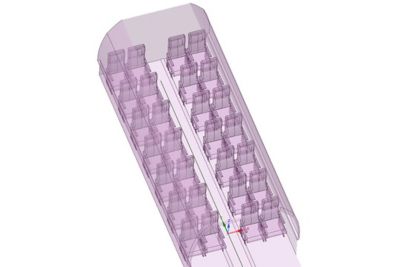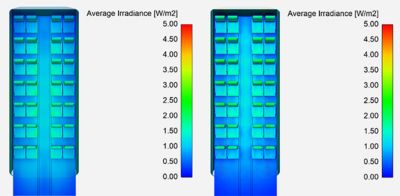-
-
Access Free Student Software
Ansys empowers the next generation of engineers
Students get free access to world-class simulation software.
-
Connect with Ansys Now!
Design your future
Connect with Ansys to explore how simulation can power your next breakthrough.
Countries & Regions
Free Trials
Products & Services
Learn
About
Back
Products & Services
Back
Learn
Ansys empowers the next generation of engineers
Students get free access to world-class simulation software.
Back
About
Design your future
Connect with Ansys to explore how simulation can power your next breakthrough.
Free Trials
ANSYS BLOG
June 5, 2020
UV Robots Can Accelerate COVID-19 Recovery for Airlines
The global COVID-19 pandemic has resulted in some of the most dramatic reductions in travel ever seen. According to the Transportation Security Administration (TSA), the number of travelers declined by a staggering 95% in April 2020 compared with a year ago. As a result, many airlines essentially grounded the majority of their fleets with airports resembling parking lots.
Simulations show that UV robots can be used to disinfect aircraft.
As restrictions on movement begin to lift, airlines must give passengers the confidence that they can travel safely in the company of strangers in a confined environment for hours at a time. While the aircraft cabin environmental control systems can help clean and filter the air, they do not address the ability of the virus to survive on interior surfaces. As a result, thorough cleaning and disinfection is necessary.
Airlines must balance this need with the economic reality of achieving a fast turnaround at the gate. The cleaning system must therefore be fast, effective and scalable across the fleet. Traditional disinfection methods struggle to meet these competing goals.
One innovative technology that has proved efficient at decontaminating hospital rooms uses a high dose of ultraviolet (UV) light to disinfect all potentially contaminated surfaces. This could supplement, or potentially replace, manual cleaning of aircraft with an automatic robotic system. Simulation has a key role to play in designing and optimizing these systems.
The Challenges to Designing Disinfecting UV Robots for the Aerospace Industry
For engineers to design and deploy an optimal disinfection system, they need to:
- Choose the best UV lighting system
- Choose the best delivery system
- Ensure the system exposes all surfaces
- Understand the dosage requirements
Engineers have a range of UV lighting choices, with the most common disinfection lamps using bulbs that emit UV light with wavelengths around 250 nm (UV-C). These provide adequate disinfection while minimizing exposure risk to the operators.
The two main delivery system options are:
- Installed UV light fixtures
- UV robot
Engineers need to ensure that UV light reaches all surfaces with the required dosage.
Fixtures are simple and they can be activated by turning on a switch. However, this option requires aircraft remodeling, and potential recertification, to ensure the systems are safe and that UV light reaches all surfaces in the environment
Any shadows can cause incomplete coverage and disinfection. This remodeling and fixture installation could be costly and time-prohibitive. In addition, permanently installed equipment comes with ongoing maintenance requirements and costs.
Autonomous UV robots can expose all the surfaces to UV light more efficiently, however, they need to be able to properly navigate the cabin during each cleaning session. So, utilizing this system isn’t as simple as turning on a switch.
As for dosage, engineers will need to determine the amount of light needed to kill the target pathogens. Based on the power output of the UV system, the dosage requirement will translate into a necessary exposure time for the light fixtures and a necessary speed for the UV robot.
Simulations Suggest that UV Robots Can Be an Optimal Method to Decontaminate Aircraft
Engineers can use Ansys simulation tools to design and virtually test the efficacy of different UV light treatment systems for the aerospace industry.
First, they can use Ansys SpaceClaim to create a 3D mock-up of the cabin. Stationary and dynamic assets, such as light fixtures and UV robots, can be added to the environment.
The cumulative irradiation on surfaces within the cabin interior
using light fixtures (left) and an optimized UV robot (right)
Engineers can then use Ansys Speos to apply optical reflectivity properties to the various objects in the cabin. They can model a UV light source with a specific power output, spectrum and distribution. The simulation will predict the cumulative irradiation on all surfaces (including non-flat surfaces) to determine the efficacy of the proposed disinfection process.
The simulation can also help to determine where shadows are formed and how much light might bounce off highly reflective objects. Finally, the worst-case exposure can be determined by evaluating the surfaces with the smallest cumulative irradiation.
In a series of simulations, the effectiveness of installed UV light fixtures was compared with UV robot solutions. The simulations showed that the installed fixtures and an optimized robot had similar performance. However, robots offer the short-term advantage of getting the airlines moving again as quickly as possible because they do not require the cabin to be remodeled and extra fixtures to be installed. They can also potentially disinfect the plane in a few minutes.
To learn more about optical engineering read the white paper, A New Era for HPC-Driven Engineering Simulation.

